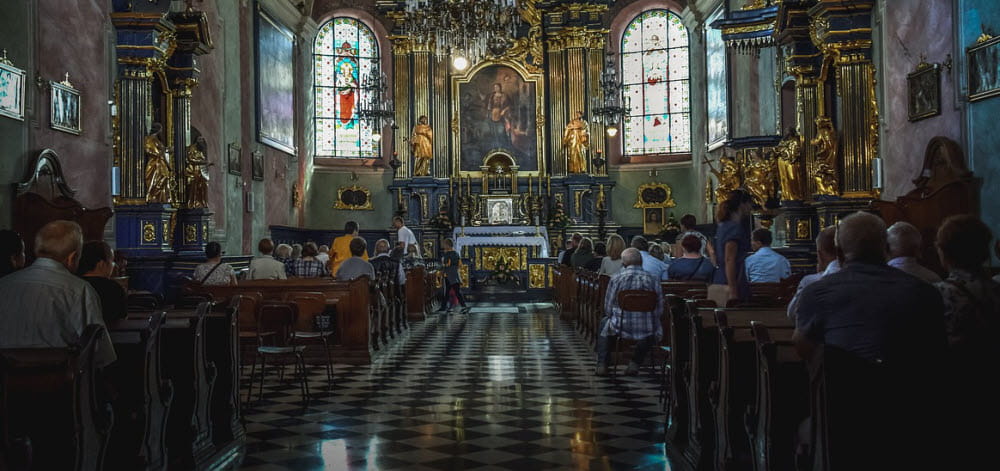Hymns, prayers and creeds are all part of Christian worship.
This free lesson plan is complete with a worksheet and is in addition to the What is Christian Worship lesson plan
This teacher’s copy of the Hymns, prayers and Creeds lesson plan is printer-friendly.

Table of Contents menu
Table of Contents:
1. Resources for Hymns, prayers and creeds lesson plan
Optional: Copy and paste ‘The Creed’ and the prayer (in blue) onto PowerPoint or interactive board.
There are two YouTube videos embedded in this page that could be played.
2. Starter for Hymns, prayers and creeds lesson plan
Imagine that something special has just happened to you.
You now want to write it down so that you can remember it and also tell others about it.
Q. In what different ways could you tell others the news?
What different forms of writing could you use?
You could write a song, a poem, a story, a play, a dance, or just write down the key points.
Christians have used many different forms of writing to help express their faith.
We’ll look at these now:
3. Main teaching for Hymns, prayers and creeds lesson plan
[1] Songs were composed to express the Christian faith:
[a] Originally Christians used the Psalms written within the Bible.
Psalm 130 is an example of one.
See if you can spot the sort of emotions the writer must have been feeling at the time:
Out of the depths of despair, I call to you, O Lord. Hear my voice O Lord.
Psalm 130 NIV
May your ears be open to my cry for mercy.
If you, O Lord, keep a long list of our sins, then who could have their prayers answered?
But you do forgive; therefore we should respect your awesome authority” (etc.)
Q. What emotions did the writer have?
He could have been in despair because of all the wrong and bad things he was doing.
So he was relying on God to have mercy and forgiveness.
But he thought that being forgiven shouldn’t be taken for granted, he wanted to respect God’s authority.
[b] For hundreds of years Christians have written songs known as hymns.
In the 1700′s, many people turned to God and it is now known as the ’18th Century Revival’.
During this time many good hymns were written.
Here is an example of a hymn written by Isaac Watts.
It starts with ‘When I survey’ which means ‘When I look at’.
When I survey the wonderous cross,
Isaac Watts
On which the Prince of glory died,
My richest gain I count but loss,
And pour contempt on all my pride” (etc).
Q. Who is the ‘Prince of Glory’ mentioned in the hymn?
(Jesus.)
Q. How was the writer picturing Jesus?
He was picturing Jesus suffering crucifixion upon the cross, (for an explanation of this see the Christian festival of Easter lesson plan – which opens in a new tab) and because Jesus was taking the penalty for all the sins of those who would turn to Him, that was creating emotion within the hymn writer.
Q. What emotions do you think the writer was experiencing?
Isaac Watts felt very humbled by this picture of Jesus.
Whatever the world could offer in the way of riches just felt insignificant when compared with what Jesus did for mankind: “My richest gain I count but loss,”
And there was no place for feeling proud when looking at Jesus upon the cross:
“And pour contempt on all my pride”
[c] New Christian songs are being written all the time.
They can be a song with many verses, or they can be very short and are then known as a ‘chorus’.
Here is an example of a chorus:
Father, I can call You Father,
Composed by Danny Daniels. Copyright 1989 Mercy/Vineyard Publishing/Adm. by CopyCare.
For I am Your child today,
Tomorrow and always,
You are my Father.”
Q. What is the focus of this chorus?
This is speaking about a relationship with God.
It is the Christian calling God: ‘Father’ ‘Daddy!’
A relationship that will last forever.
[2] Creeds were written to express the Christian faith:
A creed is made up of facts and statements which set out certain truths about the Christian faith to stop false teachings and ideas.
We will look at one which is known as ‘The Apostles Creed’ and it was written a few hundred years after Jesus walked on this earth.
(Teachers note: This could be displayed to the pupils. The creed could be read aloud by the teacher and then the children could all stand and read it together just like it is done in some Churches).
I believe in God, the Father Almighty,
The Apostles Creed
the Creator of heaven and earth,
and in Jesus Christ, His only Son, our Lord:
Who was conceived of the Holy Spirit,
born of the Virgin Mary,
suffered under Pontius Pilate,
was crucified, died, and was buried.
He descended into hell.
The third day He arose again from the dead.
He ascended into heaven
and sits at the right hand of God the Father Almighty,
where He shall come to judge the living and the dead.
I believe in the Holy Spirit,
the holy catholic* church,
the communion of saints,
the forgiveness of sins,
the resurrection of the body,
and life everlasting.”
*The words ‘catholic church’ here means the worldwide Church and catholic means universal. It’s not meaning the Roman Catholic Church.
The idea was that these creeds were to be read out at each Church service so that everyone would hear this summary of the Christian faith.
Then if someone said that Jesus was just a man, the people would remember the words of the creed and they would be able to correct them by quoting a part of the creed.
Q. Which bit of the creed would they quote?
“I believe in God, the Father Almighty, the Creator of heaven and earth, and in Jesus Christ, His only Son, our Lord”
[3] Prayers to express the Christian faith:
(Teacher’s note: This could be displayed. The prayer could be read by the teacher.
Then the children could all stand and read it together just like it is done in some Churches).
We have come together as the family of God in our Father’s presence
Anglican Book of Common Prayer
to offer him praise and thanksgiving,
to hear and receive his holy word,
to bring before him the needs of the world,
to ask his forgiveness of our sins,
and to seek his grace,
that through his Son Jesus Christ
we may give ourselves to his service.”
Q. What does the prayer say about a special relationship with God?
That God is a Father to those who meet with Him, they belong to His family:
‘We have come together as the family of God in our Father’s presence’.
Q. What does the prayer say about listening?
To listen to the Bible being read and the explanation by the preacher: ‘to hear and receive his holy word,’
But listening is not enough, because it also says: ‘to hear and receive’.
To receive means to agree with it and put it into action, so that it becomes part of that person’s life.
4. Plenary for Hymns, prayers and creeds lesson plan
Q. Do you think Christian hymns and songs are boring?
Q. Have you heard any modern Christian hymns or songs?
Teachers note: These YouTube videos could be played:
Attention – by clicking ‘play’ your browser will load all of the Youtube Cookies.
Clicking ‘play’ means you are consenting to these Cookies.
A slow song: 10,000 Reasons with lyrics opens in a new tab.
A faster song: This Is Amazing Grace with lyrics opens in a new tab.
There is a Christian hymns and songs worksheet to accompany this lesson plan.
Also, see Christian hymns and songs. RE resources
5. Frequently asked questions (FAQ)
What is a creed in Christianity?
The early church was suffering from false teachings, so creeds were devised to underline certain Christian truths to combat the heresies. These could be committed to memory and then quoted when anything contrary to biblical truth came along.
Creeds were simple summaries of the Christian faith.
What is considered a hymn?
The word ‘hymn’ comes from the Greek ‘hymnos’ meaning a ‘song of praise’ commonly used in Christian worship. The whole church gathered would join in singing the hymns which should contain biblical truth and, or, express thanks and praise to God.
What is a Psalm?
1) The word ‘Psalm’ comes from the Hebrew word: מִזְמוֹר (miz.mor) meaning ‘melody’.
2) Originally each Psalm would have had its own tune, but these have been lost over time.
3) Many Psalms were written by King David.
4) Psalms are found in the middle part of the Bible.
5) They consist of prayers, laments, praise, songs and spiritual truths.
6) Some are prophetic and talk about the coming Messiah.
7) Psalms have been used in Christian worship for centuries.
What is prayer?
Prayer is:
1) Talking to God, because he is our heavenly Father.
2) Giving adoration to God the Creator and Sustainer of all things.
3) Asking for God’s will to be done and not your own.
4) Requesting His guidance and wisdom.
5) Asking for the things we need, but not necessarily everything we want.
5) Calling for His protection so as to resist bad people and evil forces.
6) Asking in the name of the Lord Jesus Christ, because he intercedes on our behalf to God.
